Articles
- Page Path
- HOME > Korean J Community Nutr > Volume 28(4); 2023 > Article
- Research Article
- The frequency of convenience food consumption and attitude of sodium and sugar reduction among middle and high school students in Seoul: a descriptive study
-
Seoyeon Park1
 , Yeonhee Shin2
, Yeonhee Shin2 , Seoyeon Lee1
, Seoyeon Lee1 , Heejung Park3
, Heejung Park3
-
Korean Journal of Community Nutrition 2023;28(4):269-281.
DOI: https://doi.org/10.5720/kjcn.2023.28.4.269
Published online: August 31, 2023

2Student, Graduate school of Education, Sangmyung University, Seoul, Korea

3Professor, Department of Food & Nutrition, Sangmyung University, Seoul, Korea

-
Corresponding author:
Heejung Park, Tel: +82-2-2287-6163,
Email: heejp2020@smu.ac.kr
- 2,672 Views
- 26 Download
- 1 Crossref
- 0 Scopus
Abstract
Objectives
This study aimed to examine the frequency of convenience food consumption at convenience stores (CVS) and the CVS usage patterns of middle and high school students as well as to understand students’ attitude toward sodium and sugar reduction.
Methods
We used an online questionnaire for data collection. The questionnaire comprised five distinct categories: general characteristics, CVS usage, frequency of consumption according to convenience food menus at CVS, attitude toward sodium and sugar reduction, and adherence to dietary guidelines.
Results
A total of 75 students from Seoul (14 middle school students and 61 high school students) participated in the study. Most respondents visit CVS 3-5 times a week. CVS are predominantly used during weekdays, mostly during lunch, and dinner. The students mostly checked the caloric content and expiration date as food labeling information. The participants were aware of the need to reduce their sugar and sodium intake. Among frequent CVS convenience food consumers, there was an increased consideration of the need to reduce their sugar and sodium consumption, despite their actual selection of foods with high sugar and sodium content. Additionally, they did not check the sugar and sodium levels indicated in food labeling. Further, the dietary action guide from the Ministry of Health and Welfare were poorly followed by most students.
Conclusions
There is a need for nutrition education specifically addressing the sugar and sodium content of the convenience foods predominantly consumed by students. Additionally, educating students with frequent convenience food consumption to actively check the sugar and sodium information on food labels could help promote healthier food choices.
Published online Aug 31, 2023.
https://doi.org/10.5720/kjcn.2023.28.4.269
The frequency of convenience food consumption and attitude of sodium and sugar reduction among middle and high school students in Seoul: a descriptive study
Abstract
Objectives
This study aimed to examine the frequency of convenience food consumption at convenience stores (CVS) and the CVS usage patterns of middle and high school students as well as to understand students’ attitude toward sodium and sugar reduction.
Methods
We used an online questionnaire for data collection. The questionnaire comprised five distinct categories: general characteristics, CVS usage, frequency of consumption according to convenience food menus at CVS, attitude toward sodium and sugar reduction, and adherence to dietary guidelines.
Results
A total of 75 students from Seoul (14 middle school students and 61 high school students) participated in the study. Most respondents visit CVS 3-5 times a week. CVS are predominantly used during weekdays, mostly during lunch, and dinner. The students mostly checked the caloric content and expiration date as food labeling information. The participants were aware of the need to reduce their sugar and sodium intake. Among frequent CVS convenience food consumers, there was an increased consideration of the need to reduce their sugar and sodium consumption, despite their actual selection of foods with high sugar and sodium content. Additionally, they did not check the sugar and sodium levels indicated in food labeling. Further, the dietary action guide from the Ministry of Health and Welfare were poorly followed by most students.
Conclusions
There is a need for nutrition education specifically addressing the sugar and sodium content of the convenience foods predominantly consumed by students. Additionally, educating students with frequent convenience food consumption to actively check the sugar and sodium information on food labels could help promote healthier food choices.
Introduction
Recently, the consumption of convenience food has expanded, particularly among the younger generations and single-person households [1, 2]. In the context of convenience stores (CVS), convenience food refers to pre-prepared, processed, and packaged food, allowing consumers to consume it without the need for extensive cooking or through a simple and quick cooking process. CVS offer a convenient and easily accessible option for students to grab quickly a bite or purchase snacks during their busy schedules. Adolescence is a transitional stage leading to adulthood. Since adolescence affects not only growth and development but also health and disease conditions in adulthood, good eating habits in adolescence are desired [3, 4]. However, there are concerns on the nutritional status of adolescents [5, 6, 7, 8]. First, compared to other age groups, adolescents aged 12-18 years old typically have a higher sugar intake [5]. The “2021 Youth Health Behavior Survey” conducted by the Korea Centers for Disease Control and Prevention revealed some concerning trends regarding the consumption of sugar-sweetened beverages and fast food among students [6]. According to the survey, approximately 38% of students reported consuming sugar-sweetened beverages more than 3 times a week. This high frequency of consumption suggests a significant portion of students may be regularly consuming sugar-sweetened beverages, which can contribute to excessive sugar intake and potential health issues. Second, their excessive sodium intake cannot be overlooked. Sodium consumption from 2007 to 2015 consistently exceeded 200% of the adequate intake in high school students aged 16-18 years [7]. During adolescence, excessive sodium intake can have detrimental effects on calcium absorption, bone formation, and bone density [8]. Accordingly, Korean school meals have prioritized reducing sodium content [9, 10] and education on nutrition aims to encourage the consumption of potassium and magnesium-rich vegetables, as they facilitate sodium excretion [11, 12].
The Ministry of Food and Drug Safety (MFDS) announced the “Sodium and Sugar Reduction Plan” and set long-term goals for sodium and sugar intake. By 2025, daily sodium intake should be < 3,000 mg and sugar intake from processed foods < 10% of daily calorie intake [13]. According to recent amendments to the “Sodium and Sugar Reduction Labeling Standards”, the scope of products eligible for low-salt and low-sugar labeling has been expanded. This expansion now includes popular food items such as gimbap (rice rolls), instant cooked food soup, stew, hotpot, and commonly consumed ready-to-eat foods. This step aims to provide clearer information to consumers about the sodium and sugar content in these food products and facilitate healthier choices [14]. With this policy, the Ministry of Health and Welfare recommends the implementation of dietary action guide for adolescents [15, 16]. Along with the government, there are many actions to reduce sugar and sodium in school as well. For reduction practices, natural sugar such as grind pears and apples was used instead of added sugar in school meals, and raw tomatoes are used to reduce the amount of ketchup used. In addition, school meals are trying to reduced sodium by providing daily soup salinity measurement (0.4%-0.6%) or daily more grilled menu than stewed menu [17].
Both the government and schools have made significant efforts to reduce the sugar and sodium intake. Insufficient quality of nutrition education and limited exposure to comprehensive dietary guidelines can impact students’ behavior and understanding of healthy eating practices. Thus, the adherence to sugar, and sodium reduction policies, as well as the implementation of nutrition education programs, faces numerous challenges, especially in an environment with a growing CVS number.
This study aimed to examine the usage patterns of convenience foods, and the overall CVS use, among middle, and high school students based on the frequency of convenience food consumption at CVS. Furthermore, the study aimed to investigate the students’ attitude toward sodium and sugar reduction based on their frequency of convenience food consumption as well as their compliance with the dietary action guide provided by the Ministry of Health and Welfare.
Methods
Ethics statementThe study received approval from the Institutional Review Board at Sangmyung University (SMU IRB C-2021-011). |
1. Study participants
This study was based on an online survey targeting students, who voluntarily participated, from a middle school, and a high school located in Seoul. School selection was based on convenience sampling. The promotion for survey participation was conducted through the school bulletin board. The questionnaire was filled out and distributed to 100 middle and high school students between December 2021 and February 2022, and a total of 75 (male = 31, female = 44) participants’ data were used for the final analysis. The study aimed to examine the characteristics of different groups based on the frequency of convenience food consumption at CVS. The group consuming convenience store food < 1 time a week was classified as low, while that doing it ≥ 2-3 times a week was classified as high.
2. Methods Questionnaire
The questionnaire consisted of five categories including general characteristics, CVS usage, frequency of convenience foods intake, attitude toward sugar and sodium reduction, and dietary action guide compliance.
The general characteristics of participants included sex, school, monthly pocket money, and money spent on snacks from the monthly pocket money. Monthly allowance was classified into three categories: “< 30,000 won”, “30,000-50,000 won”, and “> 50,000 won.” The monthly out-of-pocket expenses for snacks were categorized into three groups: “< 30,000 won”, “30,000-50,000 won”, and “> 50,000 won.” This division was used to analyze the amount of money spent on snacks over the course of a month.
The survey on CVS usage included various aspects such as the frequency of convenience food consumption from CVS, days of use, usage time, and the importance of food and nutrition labeling. The frequency of convenience food consumption of CVS was categorized into “once every 1-2 days”, “once every 3-5 days”, “once a week”, “once every 2 weeks”, and “once a month.” In initial data collection, visit dates asked for specific days of the week, such as (1) Monday-Thursday, (2) Friday, (3) Saturday, and (4) Sunday and public holidays, and had them select the highest frequency. The final results were reported by classifying them into weekdays and weekends in consideration of response frequency. The usage times were divided into morning (9:00-11:30), lunch and afternoon (11:30-17:00), and evening (after 17:00). Among the questions regarding food and nutrition information labeling, participants were asked which of the following factors is the most important reason for choosing convenience foods from CVS: taste, price, nutrition, quantity, shape, hygiene, shelf life, and quality. In response to the question, “What food labeling items do you consider important when purchasing convenience foods at CVS?” items including expiration date, manufacturing date, additives, ingredients, and others were reported. The question, “What nutrition labeling items do you consider important when purchasing convenience foods at CVS?” included calories, total fat, trans fat, cholesterol, and others. Others include not checking.
The frequency of convenience food consumption was adjusted based on the Food Code by the MFDS [18], and summarized into a total of 25 items, including hamburger, sandwich, gimbap (rice rolls), yubuchobap (fried tofu pockets stuffed with rice), meal box, fish cake, hot bar, instant snacks (chicken skewer, fried chicken, etc.), boiled egg, instant cup noodle, instant cooked soup, stew, tteokbokki (spicy rice cakes), rice bowl dish, fruit, salad, biscuit, bread, chocolate, nuts, ice cream, soda, milk, tea, health drink, and fruit, and vegetable juices. The frequency of convenience food consumption was assessed using the following categories: “never”, “1-2 times a month”, “3-4 times a month”, and “≥ 5 times a month.”
To evaluate the attitude toward sodium and sugar reduction, we adapted and supplemented the questionnaire previously used by Kwak [19], Cho [20], and Kim [21]. This resulted in a total of 11 questions specifically designed to assess the participants’ knowledge and understanding of sodium and sugar-related information. In the sodium awareness survey, awareness of sodium intake, efforts to reduce sodium intake, check of sodium content in processed foods, level of salty in food, and amount of soup intake were surveyed. For sugar awareness survey, awareness of sugar intake, efforts to reduce sugar intake, check of sugar content in processed foods, preference for usual sweets, preference for sugar-sweetened beverages, and sweet snacks were included.
To assess the participants’ dietary habits, we used the dietary action guide provided by the Ministry of Health and Welfare. Common dietary guidelines for Koreans, based on 2020 standards, were used in this study after adapting the questionnaires to adolescents. The survey consisted of 10 questions, and the participants were asked to indicate the degree to which they met the dietary guidelines using the response options “well met”, “moderately met”, and “not met” [16, 17].
3. Statistical analysis
The number of samples was calculated by using G-power v3.1.9.6 (Universität Kiel, Germany). Statistical verification was performed using correlation analysis using SPSS v26.0 (Chicago, IL, USA). The general information of the participants is indicated as frequency and percentage, and a chi-square test, or Fisher’s exact test using cross-tabulation were used for group comparisons.
Results
1. General characteristics
Table 1 shows the general characteristics of participants in this study. The participants in this study were 41.3% male and 58.7% female students, respectively. Among the participants, 68.0% had an allowance > 50,000 won per month, followed by 18.7% with an allowance of 30,000-50,000 won, and 13.3% with an allowance < 30,000 won. With respect to pocket money used for snacks, 38.7% had > 50,000 won per month, and 36% had 30,000-50,000. In particular, in groups with high frequency of convenience food consumption at CVS, the expenditure on snacks from pocket money was significantly higher compared to groups with low frequency of convenience food consumption.
Table 1
General characteristics of study participants
2. Patterns and preferences of convenience store food consumption among participants by frequency group
Table 2 shows the CVS usage per group. CVS are commonly used during weekdays, mostly at lunch, and dinner time. When it comes to purchasing convenience foods, taste was the primary food selection criterion at CVS for most students. In addition, 71.9% of the low group and 81.4% of the high group selected expiration date as the most important item in the food labeling. As for nutrition facts, caloric information was considered the most important item for 71.9% of participants in the low group and 46.5% in the high group considering. There was a significant difference in the importance given to this information between the two groups.
Table 2
Patterns and preferences of convenience store food consumption among participants by frequency group
3. Monthly consumption frequency of convenience foods and beverages
Students typically consume various convenience foods such as gimbap (including triangular gimbap and onigiri), hot bars/sausages/hot dogs, instant cup noodles, chocolate/candy, ice cream, and soda (Table 3). Interestingly, > 70% of the respondents reported never consuming hamburger, meal box, or boiled eggs, and the consumption of yubuchobap, fish cake, instant cooked soup, fruit, salad, and healthy drinks was extremely low or non-existent. Despite the high soda consumption, the proportions of respondents who reported never consuming healthy drink and fruit/vegetable drinks were 82.7% and 76%, respectively.
Table 3
Monthly consumption frequency of convenience foods and beverages
Excluding other menus, the frequency of chocolate and soda consumption was notably higher in the group with high frequency of convenience food consumption at CVS than in that with low frequency of convenience food consumption (Table 4).
Table 4
Frequency of convenience food consumption at CVS between low and high frequency groups
4. Sugar and sodium consumption habits and taste preferences based on frequency of convenience food consumption at CVS
According to our findings, there was no significant difference in terms of attitude toward sugar reduction based on frequency of convenience food at CVS (Table 5). This includes the belief in the importance of reducing sugar consumption, actively making efforts to reduce sugar intake, and checking the sugar content when purchasing convenience food. Despite a generally high level of awareness regarding sugar reduction (67.4%-75.0%), only 9.3% checked the sugar content in nutritional labeling.
Table 5
Sugar consumption habits and sweetness preferences based on frequency of convenience food consumption
Over 80% of respondents, regardless of their frequency of consumption of convenience food, believed that sugar consumption should be reduced (Table 6). However, 86.7% of respondents did not check the sodium content when purchasing convenience food. In addition, in the low group significantly more students were making active efforts to reduce sodium intake than in the high group. There were no significant differences in response rates for other questions in preference for usual sodium content, salt levels in food, and soup intake.
Table 6
Sodium consumption habits and saltiness preferences based on frequency of convenience food consumption
5. Dietary action guide compliance based on consumption frequency of convenience food at CVS
Table 7 indicates no significant difference in adherence to the dietary action guide set by the Ministry of Health and Welfare based on consumption frequency of convenience food at CVS. Overall, > 50% of the respondents reported that they struggle to avoid overeating and increase physical activity to maintain a healthy weight. Further, most indicated usually using individual plates during meals (84%). Between groups, the response rates for “well met”, “moderately met”, and “not met” were similarly distributed across items, indicating low overall understanding, and adherence to the dietary action guide among participants. This suggests the need for improved education and awareness regarding the dietary guidelines to promote better adherence and healthier eating habits.
Table 7
Dietary action guide compliance based on frequency of convenience food purchase at CVS
Discussion
The purpose of this study was to investigate the use patterns and eating frequency of CVS among middle and high school students and to explore the students’ attitude toward sugar and sodium reduction and their compliance with dietary action guide. The study focused on individuals who had a high frequency of consuming convenience foods, aiming to identify their specific characteristics and determine the essential elements for effective nutrition education. By understanding the traits and attitude of this group, targeted nutrition education strategies could be developed to promote healthier eating habits among this population.
Food labeling includes various information about food, such as the name of raw materials, net content, manufacturing, and expiration date, nutritional components, and warning signs on the packaging or container of the product to provide accurate purchase information for the consumers. It protects consumers by allowing consumers to choose foods that meet their needs [22]. In this study, the expiration date was carefully checked and the energy information mostly checked, indicating that education on nutrition labeling is well under way. Recently, as consumers’ interest in health increases, consumers' desire to maintain health through food is increasing, and accordingly, the importance of food labeling is emphasized as an institutional device to secure food safety [23, 24]. Nutritional facts, display the type, and content of nutrients contained in individual foods, convey appropriate information about nutrition to consumers, help in rational food selection and health management, and can be used as a nutrition education tool [25]. Korea first introduced nutrition labeling in 1995, and continues to expand, and enforce mandatory nutrition labeling items. Currently, adolescents learn about food labeling in the school curriculum, but previous research showed a relatively low level of awareness and knowledge of food labeling [26, 27]. In the 2010 National Health and Nutrition Examination Survey [27], only 31.4% of adolescents responded reading nutrition labels when purchasing or selecting processed foods. However, in a recent study, > 50% of the participants checked food and nutrition labeling [29], and in a large-scale study, 33.2%-58.7% of the participants checked the nutritional labeling [30]. The present findings showed that they mostly examined the expiration date (77.3%) and > 50% of participants paid attention to the calorie information provided on the nutrition label, while only few checked for the presence of food additives (9.3%). However, this study revealed a low proportion of participants checking sugar or sodium content in nutrition labeling. This suggests a significant knowledge gap among the participants in accurately understanding and interpreting nutrition labels. Thus, education and awareness campaigns focusing on sugar and sodium content in food products are necessary to improve their ability to make informed and healthier choices.
In this study, the convenience foods predominantly consumed by students were instant noodles (including triangular gimbap), chocolate, ice cream, and soda. Instant cup noodles and triangular gimbap have high sodium content, while chocolate, ice cream, and carbonated drinks have high added sugar content. For gimbap (including kimchi gimbap, cheese gimbap, ham gimbap, etc.), the sodium content ranged from 1,200 to 1,400 mg per serving, whereas for triangular gimbap, the sodium content varies between 300 and 700 mg per serving [31]. As for chocolate, the calorie content per 100 g was 500-600 kcal, and the sugar content 23-45 g, depending on the type [32]. For Coke, a representative carbonated drink, a single serving (250 mL) contained 112 kcal of energy and 27 g of sugar [31]. Overall, most convenience store food consumed by students had a high in sodium and sugar content. Several studies have reported an association between salt intake in adolescents and various diseases. Rafie et al. [33] showed a positive association between sodium intake and obesity among Iranian children and adolescents. In a cross-sectional data analysis from the National Health and Nutrition Examination Survey conducted between 2009 and 2016, involving 9,026 children and adolescents, sodium intake was positively associated with being overweight, obesity, and central obesity in American children, even after adjusting for energy intake [34]. Similarly, the consumption of added sugars among adolescents has been associated with various diseases such as obesity and related metabolic risks, including insulin resistance, type 2 diabetes, hypertension, and metabolic syndrome [35]. Furthermore, an association between sugar and salt intake has been reported on a study involving Chinese adolescents [36]. After stratifying by sex, grades, and puberty status, dietary sodium intake was positively associated with sugar-sweetened beverage consumption in Chinese children and adolescents, particularly in young children. Especially for participants with a high frequency of convenience store visits, significantly more reported consuming chocolate and carbonated beverages ≥ 3-5 times a month than in other groups. Therefore, the intake of added sugar can be a major health concern for these individuals. Excessive sugar intake from consuming an excessive amount of carbonated beverages has been linked to an increase in the number of obese adolescents. Indeed, it is important to provide comprehensive nutritional education for adolescents on sugar and sodium intake including the potential health risks associated with their excessive consumption.
In response to the dietary action guide of the Ministry of Health and Welfare, it was found that there was in sufficient efforts to reduce their intake of sodium, sugar, or greasy foods. However, individuals who frequently visit CVS exhibit a greater determination to reduce their consumption of these substances. This suggests that those who frequently utilize CVS are aware of the nutritional issues associated with sugar, sodium, and fat. They may experience a sense of guilt due to their frequent consumption in their daily lives, leading to a heightened desire to actively reduce their intake. This highlights the importance of addressing nutritional awareness and promoting healthier food options within the CVS environment to support individuals in making healthier choices. Kwon [37] found no significant correlation between the level of sodium-related nutritional knowledge and actual sodium-related eating behaviors, suggesting that changes in perception may not translate into behavioral changes. Recent studies on American adolescents also reported high salt intake and low adherence to dietary guidelines [38]. Despite ongoing nutritional education for adolescents, simply providing knowledge may not be sufficient to drive significant reductions in sodium and sugar intake. Additional strategies and interventions are needed to effectively translate knowledge into behavior. This could include implementing policy changes, creating supportive environments, promoting healthier food choices, and engaging adolescents in interactive and practical activities that reinforce healthy eating habits.
Nutrition education is an effective method to help adolescents form healthy eating habits. In a study on changes in eating habits and nutrition knowledge after sodium nutrition education, Ahn et al. [39] reported a significant difference in sodium awareness between the education and control groups after education. Previously, Salam et al. [40] showed a positive score increase after nutrition education, demonstrating the educational effect of nutrition education on eating behavior in school-children. In addition, there were positive changes in items related to dietary attitudes and behaviors, indicating that nutrition education contributes to changes in children's eating behaviors. However, to maximize the effectiveness of this intervention, continuous training is needed.
The study presented evidence suggesting that frequent use of CVS by adolescents may be associated with higher sugar and sodium consumption. Additionally, although awareness of reducing sugar and sodium was high, individuals did not consistently check this information on nutritional labels. These findings underscore the need for comprehensive nutrition policies and education programs that emphasize the importance of carefully checking the details of nutrition labeling. On the other hand, the number of CVS across the country is increasing, and the convenience foods sold there are becoming more diverse and convenient [1, 2]. In addition, middle and high school students’ use of convenience foods are expected to gradually increase, considering their lack of time for meals due to excessive schoolwork and preference for stimulating and palatable foods rather than nutritive ones. By providing targeted education on the potential health impacts of consuming high-sugar and high-sodium foods, individuals can make more informed choices and adopt healthier eating habits. Concurrent efforts should focus on both raising awareness on nutrition labeling and promoting healthier alternatives at CVS.
The present study has various limitations such as its small scale and specific geographical area. Therefore, the present findings may not be directly generalizable to all adolescents or different geographic locations. Additionally, the study did not account for other socioeconomic factors that could influence sodium and sugar perceptions. However, despite these limitations, the study is significant in deriving valuable elements for nutrition education implementation in schools and organizations. It can be used for policies that can increase the ability to practice eating habits, such as checking sugar and sodium content among middle and high school students when eating at CVS. This result can serve as foundation for large scale research, considering various socioeconomic factors. This will allow for a more comprehensive understanding of the factors influencing adolescents' food choices and enable the development of more effective nutrition education programs and policies.
Conclusion
The adolescents in this study mostly purchased items with high sugar and sodium content rather than healthy menus at CVS. Although they know that sugar and sodium should be reduced, they did not check sugar and sodium content in food labeling. This finding was independent of the number of visits to CVS; which indicates the need to clarify the importance of checking sugar and sodium content as well as calories. Therefore, customized nutrition education is needed for targets with high frequency of convenience food consumption at CVS.
Under the current learning environment of adolescents, it is difficult to reduce the rate of use of CVS. Since instant cup noodles are the most consumed by teenagers, it is desirable to control its sodium content or to make the sodium content stand out on the food label. Similarly, the sugar content in the product should be more visible. Alternatively, highlighting the sugar content of products or highlighting points such as “no sugar” could help adolescents make healthier choices.
In conclusion, it is crucial to recognize the differences in thoughts and behaviors among adolescents when designing and implementing broad nutrition education programs. Accordingly, a multidisciplinary approach is needed including comprehensive nutrition education only focused on basic nutrition but also on the importance of critical thinking, mindful eating, and understanding the impact of food choices on overall health.
Conflict of interest:There are no financial or other issues that might lead to conflict of interest.
Funding:This research received no external funding.
Data availability
The participants of this study did not give written consent for their data to be shared publicly. Due to the sensitive nature of the research, supporting data is not available.
References
-
Choi MK, Park ES, Kim MH. Home meal replacement use and eating habits of adults in one-person households. Korean J Community Nutr 2019;24(6):476–484.
-
-
Ministry of Education, Ministry of Health and Welfare. Korea Centers for Disease Control & Prevention. The 13th Korea youth risk behavior web-based survey. Cheongju: Korea Centers for Disease Control & Prevention; 2017.
-
-
Kim JA, Lee SY. The study of dietary habits and health behaviors according to nutrition label utilization in Korean adolescents: Based on the 2016-2018 Korea National Health and Nutrition Examination Survey. J Korea Home Econ Educ Assoc 2021;33(2):45–56.
-
-
Korea Disease Control and Prevention Agency. Youth health behavior survey, 2022. Cheongju: Korea Disease Control and Prevention Agency; 2021.
-
-
Kim SH. Trends in food and nutrient intake of high school students based on the Korea National Health and Nutrition Examination survey 2007~2015. Korean J Food Nutr 2020;33(5):447–458.
-
-
Lee KS. Use of salimeters and sodium reduction education in school foodservice in the Gyeonggi area. J Korean Diet Assoc 2013;19(2):173–181.
-
-
Ha IH, Lyu ES. Awareness, practice, and obstruction of sodium reduction by middle school dietitians in Busan area. Korean J Food Cook Sci 2015;31(2):225–232.
-
-
Morris RC, Schmidlin O, Frassetto LA, Sebastian A. Relationship and interaction between sodium and potassium. J Am Coll Nutr 2006;25(S3):262S–270S.
-
-
The National Health Promotion Policy Deliberative Committee. Health Plan 2030. 5th ed. Seoul: Korea Health Promotion Institute; 2022.
-
-
Korean Law Information Center. Act on labeling and advertising of foods [internet]. Ministry of Government Legislation; 2023 [cited 2023.05.18].Available from: https://law.go.kr/ .
-
-
Ministry of Health and Welfare. Dietary action guide for adolescents. Sejong: Ministry of Health and Welfare; 2010.
-
-
Ministry of Health and Welfare. Dietary action guide. Sejong: Ministry of Health and Welfare; 2020.
-
-
Seoul Metropolitan Office of Education. 2023 School meal guideline. Seoul: Seoul Metropolitan Office of Education; 2023.
-
-
Ministry of Food and Drug Safety food standards division. Food Code. Cheongju: Ministry of Food and Drug Safety; 2019.
-
-
Kwak IK. In: Intake patterns of Ramen and the awareness of sodium by high school students [Master’s thesis]. Ulsan University; 2012.
-
-
Cho SK. In: Effects of the perception and education about sodium on children’s dietary habits [Master’s thesis]. Kyung Hee University; 2011.
-
-
Kim HY, Lee JS, Hwang JY, Kwon SH, Chung HR, Kwak TK, et al. Development of NQ-A, nutrition quotient for Korean adolescents, to assess dietary quality and food behavior. J Nutr Health 2017;50(2):142–157.
-
-
Ministry of Food and Drug Safety. A manual for food labeling standard. Cheongju: Ministry of Food and Drug Safety; 2011.
-
-
Hyon SM, Kim JW. Improvement of dietary attitudes of elementary students by nutrition labeling education. Korean J Community Nutr 2007;12(2):168–177.
-
-
Goh EK, Park ES. Intake of processed food and perceptions of food labeling in middle school students. Korean J Hum Ecol 2010;19(1):179–189.
-
-
Lee JI, Kim JH, Jung IK. Perception and usage of food & nutrition labels in junior high school students. Korean J Community Living Sci 2008;19(4):559–568.
-
-
Ministry for Health and Welfare. Korean National health and nutrition survey. Sejong: Ministry for Health and Welfare; 2010.
-
-
Lee SK, Choi MK, Kim M. Study on middle and high school students’ use of convenience foods at convenience stores in Incheon. Korean J Community Nutr 2019;24(2):137–151.
-
-
Lee SJ, Ryu HK. Dietary lifestyle status of adolescents: Analysis of large-scale survey data in Korea. J Korean Soc Food Sci Nutr 2021;50(1):95–111.
-
-
Ministry of Food and Drug Safety. Nutrient database [internet]. Ministry of Food and Drug Safety; 2023 [cited 2023.05.23].Available from: https://various.foodsafetykorea.go.kr/nutrient/ .
-
-
Rural Development Administration National Institute of Agricultural Sciences. Korean food composition database [internet]. Rural Development Administration National Institute of Agricultural Sciences; 2023 [cited 2023.05.23].Available from: http://koreanfood.rda.go.kr/kfi/fct/fctFoodSrch/list .
-
-
Rafie N, Mohammadifard N, Khosravi A, Feizi A, Safavi SM. Relationship of sodium intake with obesity among Iranian children and adolescents. ARYA Atheroscler 2017;13(1):1–6.
-
-
Kwon YH, Kim HS. Effects from the use of nutrition labels and the levels of sodium-related nutrition knowledge on the consumption of instant noodles (Ramyeon) by middle school students in the Incheon area. Korean J Community Nutr 2022;27(5):397–405.
-
-
Ahn SH, Kwon JS, Kim KM, Yoon JS, Kim HK. Evaluation of consumer nutrition education program to reduce sodium intake based on social cognitive theory. Korean J Community Nutr 2015;20(6):433–446.
-

 KSCN
KSCN
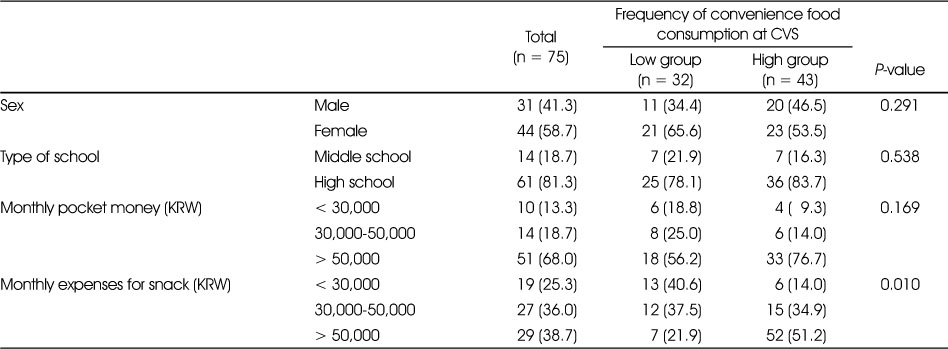
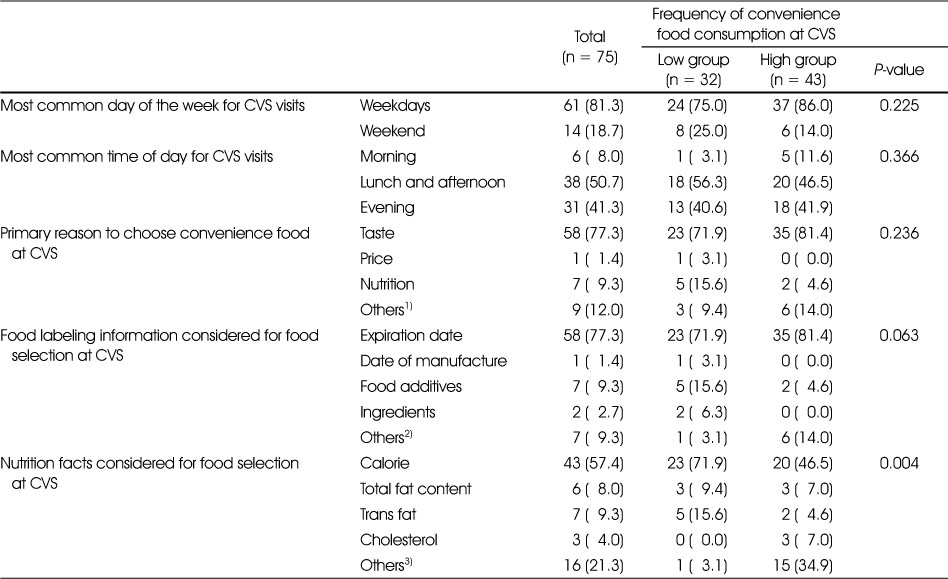
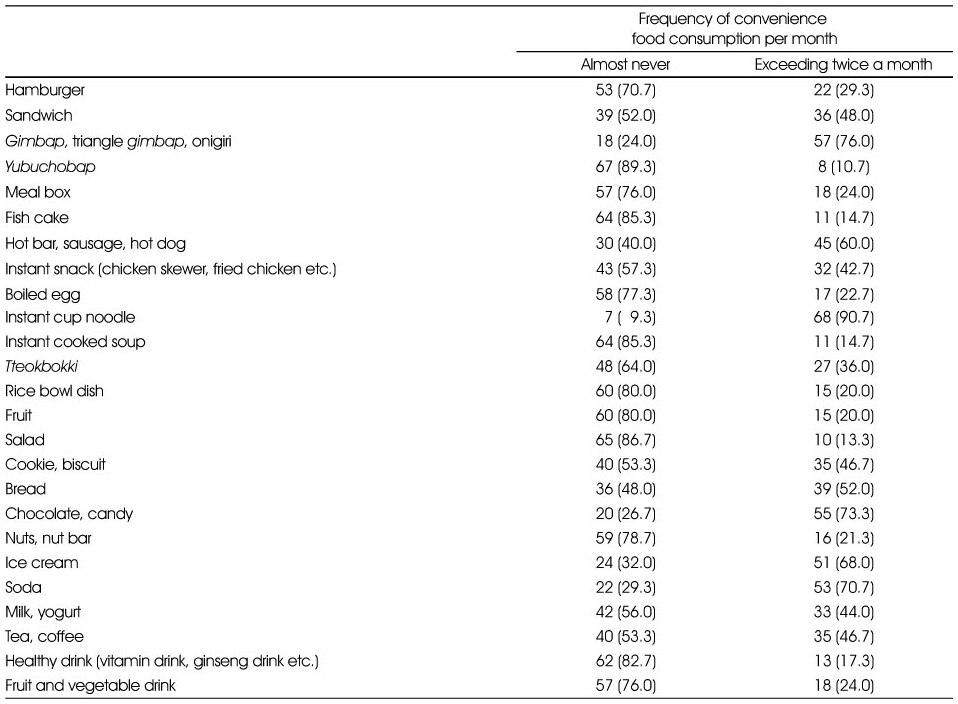
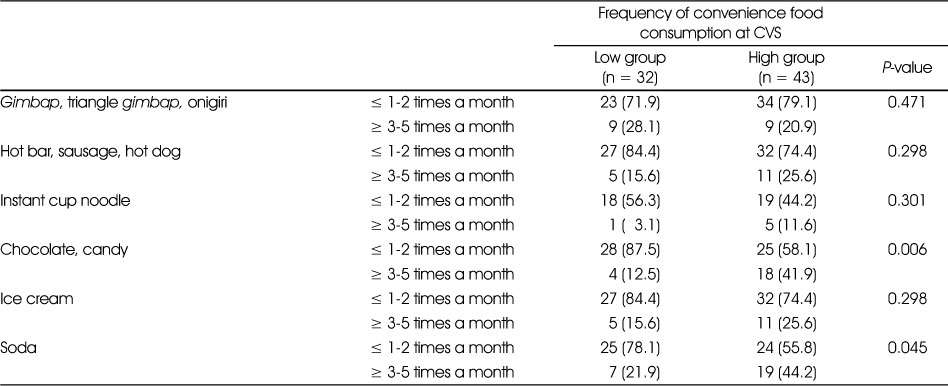
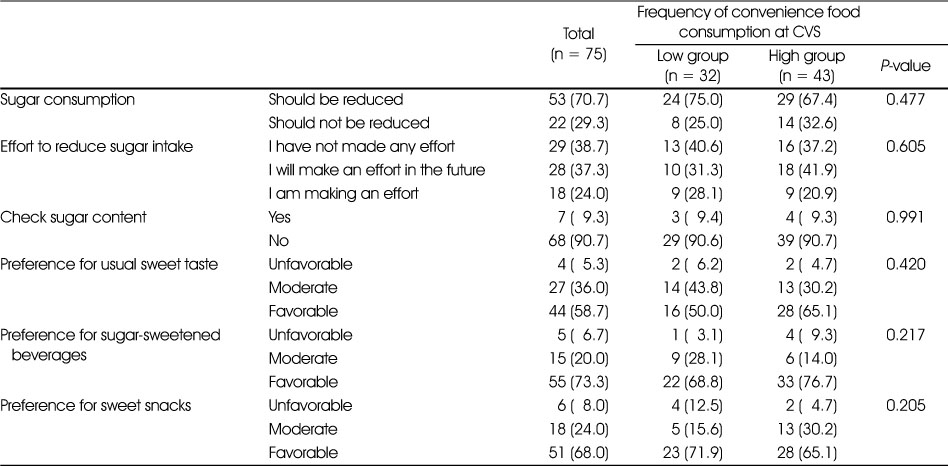
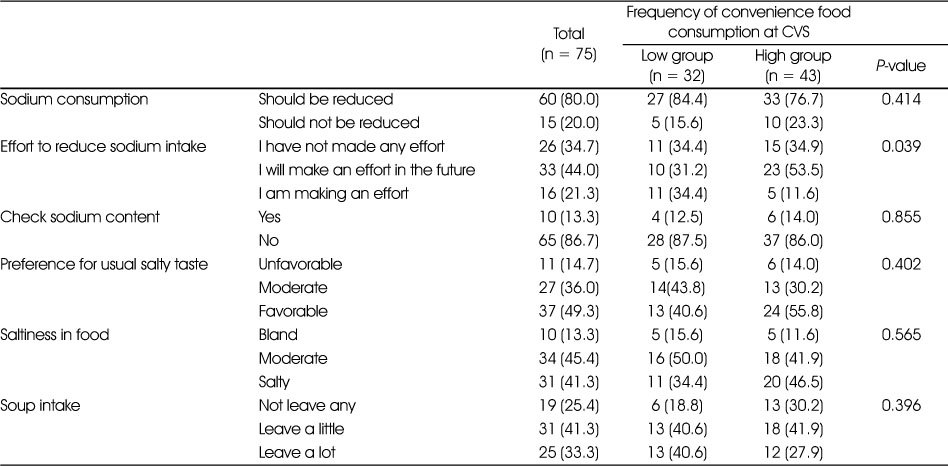
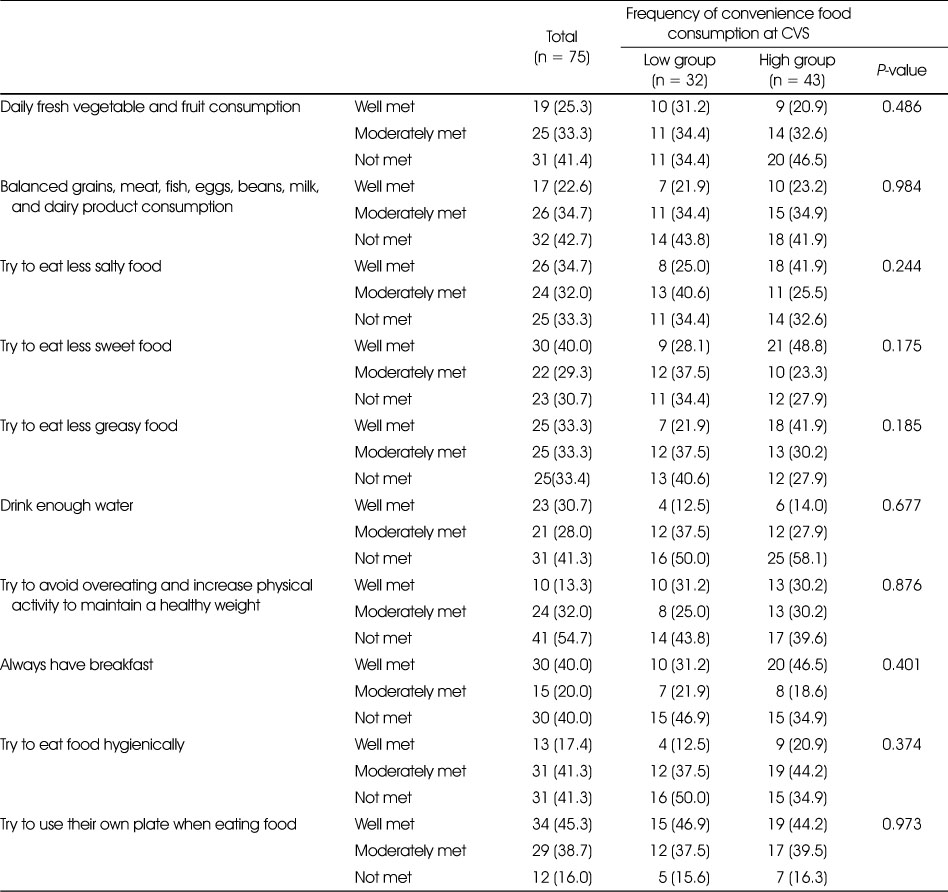

 Cite
Cite


